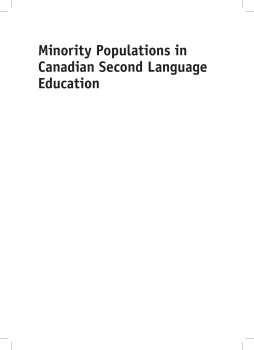
BOOK
Minority Populations in Canadian Second Language Education
(2013)
Additional Information
Book Details
Abstract
Until now, the picture painted of French second language learning in Canada has tended to focus on successful French immersion. This volume offers a broader representation, in response to the demographic changes that have made the French language classroom a more complex place. Focusing on inclusion and language maintenance, the chapters discuss how a multilingual population can add the two official languages to their repertoire whilst maintaining their languages of origin/heritage; how the revitalization of Indigenous languages can best be supported in the language classroom, and how students with disabilities can be helped to successfully learn languages.
This volume provides a review of the complex and vibrant historical and contemporary situations in Canadian second language education. Students and researchers internationally will find Canada's experiences in this regard fascinating. The editors have ably brought together the work of scholars in diverse second language education fields: official language(s) education for newcomers; heritage language maintenance programs; second language education for persons with disabilities; and revitalization and maintenance programs for Aboriginal languages. This very wide scope is matched by chapters that consider in depth and detail language education provisions for these diverse groups.
Teaching these languages poses its own set of problems: a lack of qualified teachers, few appropriate materials, and little knowledge of how best to approach these issues. This volume is an excellent starting point for research in these four areas. Each chapter has a copious bibliography and neatly describes the issues at hand. The writing is clear; it avoids overwhelming the reader with statistics and jargon but remains scholarly. Anyone interested in different language issues in Canada would be well advised to start here.
Helene Ossipov, Arizona State University, USA
This timely volume insightfully analyzes both the accomplishments and omissions in Canadian language policies over the past 40 years. Katy Arnett and Callie Mady have expanded the lens from the celebrated success of French immersion programs oriented to developing French skills among English-speaking students to include the range of multilingual realities currently found in Canadian schools. They focus on language learning opportunities (or lack thereof) afforded to social groups that have frequently been marginalized in Canadian society, specifically students from immigrant backgrounds, special needs students, and those from Aboriginal communities. The volume brilliantly sets the stage for a national discussion aimed at injecting coherence into Canadian language policies.
Katy Arnett is Associate Professor, St Maryâ??s College of Maryland, USA, having worked in second language education for 12 years. Her research interests include inclusion in second language learning and newcomer learning, and she is the author of Languages for All: How to Support and Challenge Students in a Second Language Classroom (Pearson Education Canada, 2013).
Callie Mady worked as a language teacher for 16 years and is presently an Associate Professor at Nipissing University, Canada. Her research interests include inclusion in second language education and additional language learning. She is currently the President of the Canadian Association of Applied Linguistics.
Table of Contents
| Section Title | Page | Action | Price |
|---|---|---|---|
| Contents | v | ||
| Contributors | vii | ||
| Introduction: Broadening the Lens of Second Language Education in Canada: Minority Populations in Canadian Second Language Education | xi | ||
| Part 1 French as an Additional Language: Immigrants’ Learning of French in English-dominant Canada | 1 | ||
| 1 Adding Languages, Adding Benefits: Immigrant Students’ Attitudes Toward and Performance in FSOL Programs in Canada | 3 | ||
| 2 Learning French in British Columbia: English as Additional Language Learner and Parent Perspectives | 22 | ||
| 3 French is Hard: An English Language Learner’s Experience in Core French | 38 | ||
| Part 2 Heritage Language and Culture Maintenance for Immigrants and Their Families | 53 | ||
| 4 Fostering Heritage Languages and Diasporic Identities: The Role of Grassroots Initiatives in Alberta and British Columbia | 55 | ||
| 5 Self, Identity and Motivation in the Development and Maintenance of German as a Heritage Language | 71 | ||
| 6 Learning Chinese as a Heritage Language | 87 | ||
| Part 3 Individuals with Disabilities and Second Language Study | 101 | ||
| 7 The Genesis and Perpetuation of Exemptions and Transfers from French Second Language Programs for Students with Diverse Learning Needs: A Preliminary Examination and Their Link to Inclusion | 103 | ||
| 8 Reading Without Borders: At-Risk Students Transitioning from L1 to L2 in French Immersion | 118 | ||
| 9 The Writing Processes of a Grade 7 French Immersion Student with AspergerSyndrome | 135 | ||
| Part 4 The Revival, Maintenance and Growth of Aboriginal Languages in Canada | 151 | ||
| 10 A Fair Country? Consideration of Canada’s Debt to Indigenous Language Renewal | 153 | ||
| 11 First Nations, Métis and Inui tK-12 Language Programming: What Works? | 169 | ||
| 12 How Have Aboriginal North Americans Responded to Writing Systems in Their Own Languages? | 184 | ||
| Conclusion: Additional Conceptions of Second Language Education in Canada | 199 | ||
| Index | 201 |
